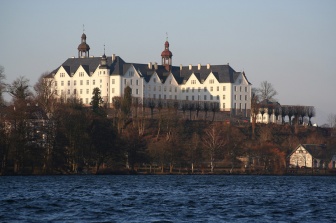Germany is a land filled with historical buildings and German castles and forts are among the most renowned in the world. Each week I publish a post about a German castle or fort and tell you – my readers – about its history, important things to see there and much more.
In the northern German state of Schleswig-Holstein, lies one of Germany’s most beautiful castles: Plön Castle. The castle gets its name from the city it is situated in, and the edge of the lake it is built upon. The castle has a colorful and chequered history. It was first built during the 10th century as a defensive fortification on a hill. Schleswig-Holstein is a very flat state and a hill was seen as a natural place to build such a structure. The castle originally called Plön Castle was built on an island on the Lake Plön, but was later moved to the bank of the lake. Plön was initially under Danish rule. During the Danish Civil War – also called the Count’s Feud – the castle was burned and then rebuilt. The estate was transferred to the Duchy of Schleswig-Holstein-Sonderburg. It was later granted to the Duchy of Schleswig-Holstein-Plön. Continue reading









